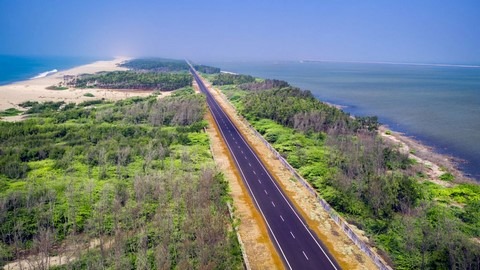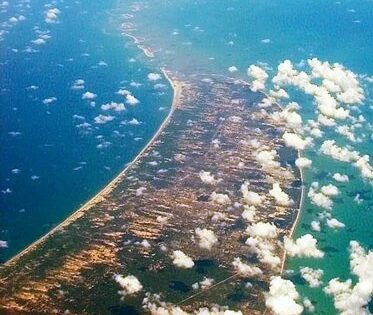Dhanushkodi: Land of Ram Setu, India’s perennial bridge to Sri Lanka
Known for matchless serenity, away from urban hustle and bustle, this serene land which connects India and Sri Lanka provides one of the most picturesque views to its visitor. Dhanushkodi, separated from the mainland by the Palk Strait, is the land border between India and Sri Lanka, with the Emerald Isle merely 15 km away.
And going by the popular Hindu belief as well as the epic Ramayana, even this 15 km of sea had been overcome by a bridge built by Lord Rama’s trusted aide monkey-faced Lord Hanuman and his army of monkeys. In fact, that episode also lends its name to the this beautiful land’s end.
The term Dhanushkodi translates as ‘end of a bow’, which refers to the legend that Lord Rama, considered one of the greatest archers of his time, is said to have ordered Hanuman to construct a bridge, that his army could use to cross the ocean to reach Sri Lanka, where his wife Sita had been kept captive by the demon King Ravana. Hanuman obliged and began the construction with the help of Nal and Neel, who had expertise in the craft. They were duly assisted by the army of monkeys who were Hanuman’s followers.
After Rama and his army crossed over into Sri Lanka and destroyed Ravana’s Kingdom in a battle, they returned to India. Legend has it that upon their return to India, Lord Rama, at the request of Vibhishana, the new King of Sri Lanka who had helped Rama in his battle, shot an arrow named Karmukh onto the bridge, which broke the bridge into three parts, which subsequently destroyed the bridge and made it impregnable for anybody to cross it, thus making Lanka safe again.
It is also said that there is a particularly beautiful stretch of sandy shore visible from Dhanushkodi that represents the beginning of the Ram Setu bridge.
“Dhansuhkodi is one of the best places that I have ever visited in my life. There are a lot of things to be explored at this place. People do not only visit this place because of its religious significance but also because of the natural beauty that this land has been blessed with,” Nitish Sharma, a software developer from Ghaziabad , who visited Dhanushkodi in 2022, tells Media India Group.
A devastating cyclone hit Dhanushkodi in 1964 and washed away almost the entire town. As fate would have it, the temple was one of the few structures still left standing at the end of the cyclone and has been one of the key pilgrimage sites in this part of India.
Best Time to Visit
The period from October to March is considered to be best suited for visiting this heavenly beach town as it is not too warm.
Places to Visit
Kothandaramaswamy Temple
Believed to be more than 1,000 years old, the Dhanushkodi Temple, also known as Kothandaramaswamy Temple, is one of the most popular tourist destinations in Dhanushkodi. The temple is named Kothandaramaswamy Temple and it is dominated by an idol of Lord Rama holding his bow or Kothandam.
Many devotees come here to see the land where Lord Rama is said to have begun his journey to Lanka in order to rescue Sita. Besides the religious significance, Dhanushkodi is also equally captivating for its scenic beauty, surrounded as it is with a vast expanse of ocean and shimmering sand.
Ram Setu
Besides the temple, it is one of the most popular spots for visitors to Dhanushkodi. To get to the Ram Setu, visitors need to take a ferry from the seashore. The ferry takes them on a short cruise to the sand dunes that are meant to signify the remnants of the beginning of Ram Setu which stretched all the way across the 15 km of Palk Strait separating the two countries. The ferry takes 15-20 minutes to complete the trip.
The presence of limestone shoals at this spot is used by believers to push the hypothesis that Ram Setu did exist and stretched all the way to Sri Lanka. The belief is that it begins from Dhanushkodi and ends at Mannar Island in Sri Lanka. It is also said that it was used as a connecting bridge between the two countries until it was hit by a cyclone in 1480, which led to the destruction and submersion of most of the bridge.
Dhanushkodi Beach
Dhanushkodi Beach is considered one of the most exotic adornments along the vast coastline of Tamil Nadu. The beach is visited by hundreds of thousands of tourists every year from all over the world. It is breath-taking to see the magnitude of the Ocean, as well as seemingly endless beautiful places that line the coast.
The pure white sand and incredibly bright blue sea create an exotic and peaceful atmosphere. The tides are not very high and the sand is very soft, which makes this beach very popular with travellers looking for a dose of culture in a remote paradise.
Pamban Bridge
It has been one of the main points of attraction for tourists. This wonderful man-made bridge is a living example of great architectural excellence. Built in 1914, Pamban is India’s first sea bridge, which connects Rameshwaram to mainland India. With an elevation of 12.5 m from the sea, the bridge extends over 2.05 km and was for decades the longest bridge in India. Though the bridge suffered major damage in the 1964 cyclone, it was subsequently rebuilt and is being used even today.
Apart from these places, there are numerous other spots near Dhanushkodi that can be explored. These include the Gulf of Mannar Marine National Park, Pamban Island, the Agni Theertham Beach and hundreds of temples and religious shrines.
How to get here
To visit Dhanushkodi, one needs to book a cab or take a bus from Rameshwaram, which is better connected with the rest of the country. Tuticorin and Madurai are two of the nearest airports, located at 142 and 149 km, respectively, from Rameshwaram.
Rameshwaram is also conveniently connected by road to other parts of the country. The local transportation association oversees regular bus service to other cities and locations. Rameshwaram can also be reached by car via various routes.
Where to Stay
Although not many facilities are available in Dhanushkodi, there are several places to stay in Rameshwaram. Daiwik Hotels Rameswaram, Hotel Rameswaram Grand, Hotel Ashoka, and Rameswaram Blue Coral Cottage are some of the popular places to find an abode during a sojourn here. In addition to that, there are countless numbers of religious shrines where devotees can stay during their religious journey.












